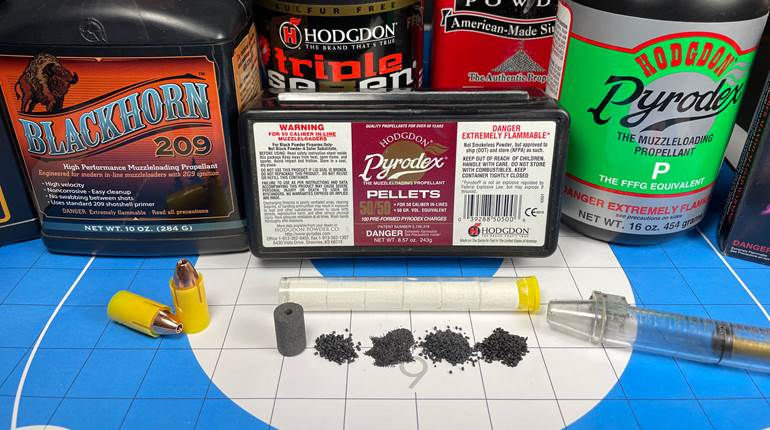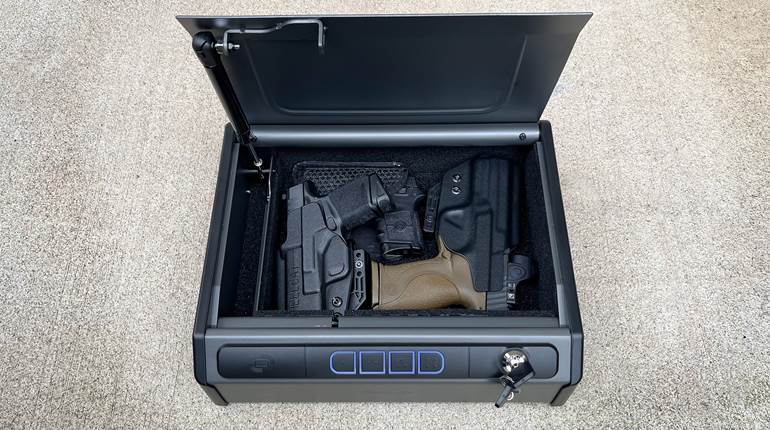
Top: These 7 .30-cal. bullets have different designs of grooves around their shanks. From the left, the bullets are Barnes 150-gr. Triple Shock; Cutting Edge 100-gr. ESP Raptor; Cutting Edge 150-gr. ER Copper Raptor; Hornady 150-gr. GMX; Hammer 181-gr. Hunter; Federal Premium 180-gr. Trophy Bonded Tip and Federal Premium 200-gr. Edge TLR.
The grooves cut around the shank of many of today’s bullets solve the problems associated with single-metal bullets constructed entirely of copper, gilding metal or brass and some bullets with a lead core bonded to a copper-alloy jacket and solid shank.
Bullets with grooves cut around their shanks help reduce bore fouling and reduce pressures from the long bullets.
The difficulties and their solutions with these single-metal bullets is chronicled by the evolution of the Barnes X Bullet introduced in 1989. X Bullets developed a great reputation for deep penetration in game and near complete weight retention. However, accuracy was so-so in many rifles and copper fouling in the bore was considerable.The copper bullets were also long for their weight, compared to bullets of the same caliber and weight made with a lead core and copper-alloy jacket. That increased bearing surface, and pressure. Barnes’ first solution was XLC coating on X Bullets to decrease friction and fouling. Randy Brooks, the inventor of the X Bullet and owner of Barnes at the time, had been experimenting with a series of rings cut around the shank of X Bullets. The final version of the grooves measure slightly under bore diameter to reduce bearing surface and provided a place to deposit material scraped off by the rifling lands. The result was lower pressure and less bore-fouling. Barnes named the bullet the Triple-Shock X Bullet and introduced it in 2003.
Grooves in bullets are not exactly new. Nosler’s original Partition bullets from 60 years ago featured a “relief groove” around the harder Partition midsection to decrease pressure. Lubrication grooves on cast lead-alloy bullets not only hold lubricant, but provide a port for material displaced by rifling.
In recent years other companies have modeled their bullets with various rings and grooves to solve the problems of pressures and fouling. I shot seven 30-cal. bullets with various designs of grooves and rings into bundles of paper. Recovered bullets revealed how well the designs worked.
Hornady
Hornady GMX bullets are made of gilding metal comprised of 95 percent, which is commonly used for bullet jackets. Hornady’s Neal Emery said the main purpose of grooves on GMX bullets is to reduce the bullet’s bearing surface to lower pressure. “Because GMXs are harder than copper,” he said, “they don’t foul much to begin with and the grooves can further reduce fouling.”
GMX .30-cal. 150-gr. bullets have a crimping cannelure .294” in dimeter and a pressure relief groove below that .293” in diameter. The narrower than bore diameter grooves provide a place to deposit metal displaced by rifling lands engraving the bullet. “We’re talking about a very small amount of metal, though” Emery said.
Emery said mono-metal bullets don’t flex like lead core bullets on firing to upset and fill a rifle’s bore. The narrow grooves may allow a bullet, like the GMX, to compress on firing to obturate in the bore and provide better accuracy. “At least a little bit,” he said.
Recovered GMX .30-cal. 150-gr. bullets showed a slight amount of material engraved from rifling lands had collected in the relief groove. Back of the groove to the start of the boat tail is full diameter and the lands of the rifling fully engraved that section.
Hornady .30-cal. GMX 150-gr. bullets have a pressure relieve groove with a diameter of .293”.
Federal Trophy Tip and Trophy Long Range
Federal Premium’s Trophy Bonded Tip bullets are constructed with a front lead core bonded to a jacket and a copper solid shank. The 3 grooves on .30-cal. 180-gr. bullets slightly increase in diameter from .289” across the top groove, .292” on the middle and .295” on the bottom.
Recovered bullets exhibited no material in any of the 3 grooves. Rifling lands engraved the tops of the bands between the grooves.
Federal Premium 180-gr. Trophy Bonded Tip bullets have 3 grooves cut around their shank. Nickel-coating on the bullets further help reduce bore fouling.
Edge TLR (Trophy Long Range) bullets are constructed similarly to Trophy Tip bullets. When Federal Premium engineers developed Edge TLR bullets they detected normal grooves caused more aerodynamic drag that increased bullet drop and wind drift. Testing the number and location of grooves, engineers discovered 1 strategically placed AccuChannel groove achieved the same benefits and accuracy as multiple grooves. The AccuChannel sloped rear wall allows air to slip in and out of the groove and increase the TLR’s ballistic coefficient.
Federal Premium 30-cal. 180-gr. Trophy Bonded Tip bullets have 3 grooves, while the Federal Edge TLR 200-gr. bullet has only one
The single AccuChannel was .293” in diameter on .30-cal. 200-gr. TLR bullets. Rifling lands inscribed the length of the full diameter of the bullets, about half the bullets’ length.
Cutting Edge
Cutting Edge bullets are machined from copper or brass and contain several grooves narrower than normal bore diameter, rings of bore diameter or a band slightly larger than bore diameter. Match/Tactical/Hunting bullets have a SealTite Band, slightly wider than bore diameter around their shank that bear against rifling grooves. According to Cutting Edge the Band “ensures there will be no pressure escaping around the bullet when fired.” ER Copper Raptor bullets also have a SealTite Band and Material Displacement Grooves that provide a place to deposit material sheared off by rifling lands. 
Single-metal bullets are relatively long for their weight. These .30-cal. bullet show the difference. On the left is a Cutting Edge 150-gr. ER Copper Raptor and on the right a Hornady 150-gr. GMX. For comparison is a Sierra 150-gr. SBT GameKing with a lead core and copper-alloy jacket.
Recovered ER Copper Raptor .30-cal. 150-gr. bullets showed rifling lands had engraved only the front SealTite Band and 3 rings of bore diameter. An ever so slight amount of copper from the Band and rings was deposited in the Displacement Grooves.
This recovered Cutting Edge ER Copper Raptor bullet shows rifling lands engraved the front SealTite Band and rings between the Material Displacement Grooves.
This recovered Barnes .30-cal. 150-gr. Triple Shock bullet shows how the rifling lands ride on the bullet’s bands.

This recovered Hornady .30-cal. 150-gr. GMX bullets shows rifling lands road over the top of the crimping cannelure, relieve groove and on down the full-diameter shank.
Cutting Edge Enhanced System Projectile (ESP) Raptor bullets are machined from brass. The front parallel section of the bullets are sized to ride on the tops of the rifling lands and the bands on the shank are bore diameter to bear against the rifling grooves. ESP Raptor .30-cal. 100-gr. bullets measure .299” in diameter on the front parallel, .308” on the 3 bands and .290” in the 3 Material Displacement Grooves.
Cutting Edge .30-cal. 150-gr. ER Copper Raptor bullets are machined with Material Displacement Grooves that are narrower than bore diameter.
Recovered ESP Raptor 100-gr. bullets showed rifling lands had engraved only the 3 bands on the shank. No brass had been deposited in the grooves.
Hammer Bullets
Hammer Bullets are lathe-turned copper bullets that incorporate a continuous up and down curve on their bearing surface called “parabolic drag reduction” (PDR) that reduce rifling engraving pressure. These series of grooves around the shank are cut .005” to .0010” over groove diameter to provide less bearing surface with the bore and provide a place to deposit copper displaced by the rifling lands.
Hammer Hunter .30-cal. 181-gr. bullets contain 4 of these cuts around their shank. A noticeable amount of copper, engraved from rifling lands, had collected in the PDR cuts. \
\
Hammer Hunter bullets incorporate a series of “parabolic drag reduction” grooves cut to provide less bearing surface with the bore.
No matter the shape, depth or number of grooves bullet manufacturers place around their bullets with a solid shank, they have solved the drawbacks of fouling and excessive pressure, resulting in great all-around game bullets.

Single-metal bullets cut with grooves on their shank provide good accuracy, as this group shows that was shot with Cutting Edge 100-gr. ESP Raptor bullets fired from a .308 Win. rifle.

This 5-shot group was fired with Hornady 150-gr. GMX bullets and Reloder 17 powder.
This 5-shot group was fired with a .308 Win. rifle firing Barnes 150-gr. Triple-Shock bullets and Varget powder.






































